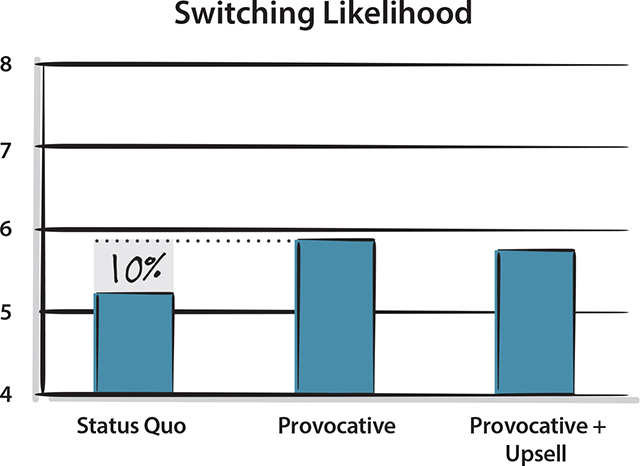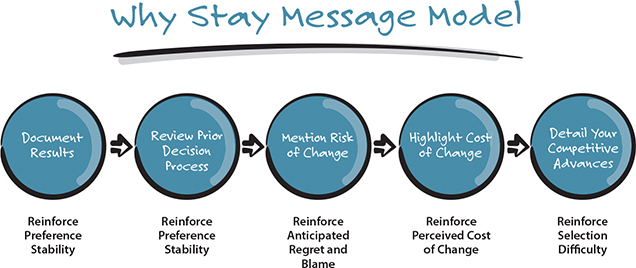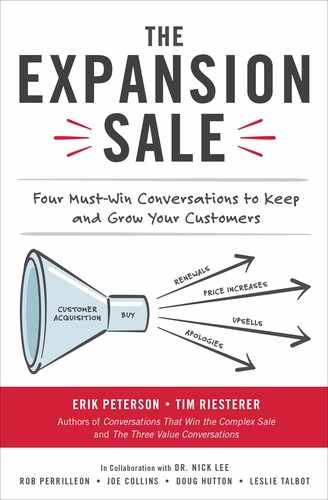 3
3 
Why Stay and the Psychology Behind Renewals
When you’re messaging to new prospects, you’re trying to disrupt their status quo. That means that before you can make the case for choosing you, you must first make the case for change. But as you saw in the previous chapters, that edgy, disruptive message you used to bring them in the door undermines your primary advantage when it comes to existing customers—your incumbency.
So what is the best way to capitalize on your Incumbent Advantage and deliver a message that reinforces, rather than disrupts, the status quo?
That’s what our Why Stay Renewal Study aimed to find out.
THE WHY STAY RENEWAL STUDY
Together with Dr. Zakary Tormala, we tested three types of messages to determine which would be most effective in a hypothetical renewal scenario.
At the outset of the study, participants were instructed to imagine that they ran a small business and that two years ago they had signed up with a 401k provider to help promote their company’s retirement plan to employees. Their objective was to boost employee satisfaction and retention by getting more people to sign up.
Participants were also told that two years ago only 20 percent of their employees subscribed to the 401k plan, against a goal of 80 percent. Now, two years later, participation had risen to 50 percent—higher than the previous 20 percent but still short of the 80 percent target. Meanwhile, employee retention rates had improved, but it was difficult to know how much of that was attributable to promoting the 401k plan.
The participants were divided across each of the three approaches, or study conditions. They only got to view and listen to one type of renewal pitch. The opening paragraph of each pitch was identical across the three conditions, but then each of the pitches varied in crucial ways:
• Pitch #1: Status Quo Reinforcement. Participants in this group received an encouraging description of how the plan was working to date and heard how the company was progressing toward its goals. They also read a message intended to reinforce the status quo, emphasizing how much effort went into selecting the current provider and highlighting the risks and costs associated with switching to a new one.
• Pitch #2: Provocative Why Change Pitch. This message documented the results to date but then switched gears, introducing a new idea that challenged the current approach. This message noted that it can be harder to make the jump from 50 percent to 80 percent participation than it is to go from 20 percent to 50 percent, and that doing so may require different tactics, such as switching the 401k plan from an “opt-in” approach to an “opt-out” one. The provider would help make this change.
• Pitch 3: Provocative Pitch with Upsell. This message was the same as the provocative pitch above, except it also offered a selection of new online tools to help engage employees in reaching their goals. The new tools would add 5 percent to the overall program costs, with an anticipated payback in fewer than 12 months.
After hearing their respective message, participants answered a series of questions designed to assess their reactions to the message and its persuasive impact. The questions focused on participants’ intention to renew, attitudes toward the provider, likeliness to switch, and credibility.
REINFORCING STATUS QUO BIAS: WHAT THE RESEARCH REVEALED
Across the measures assessed in the experiment, the status quo reinforcement message outperformed both the provocative and the provocative with upsell message by significant margins.
The message that documented success and reinforced the Status Quo Bias delivered the following results:
• 13 percent boost in intention to renew relative to the two provocative messages. To measure this, participants were asked how likely they would be to renew with their current provider and how likely it was that they’d stick with that provider (Figure 3.1).

Figure 3.1 The status quo reinforcement message outperformed the provocative messages by 13 percent when it came to “intention to renew.”
• 9 percent boost in positive attitudes compared with the other two pitches. Participants had significantly more favorable impressions of the provider than in either of the message conditions that challenged the current approach with a new idea.
• 7 percent lift in credibility perceptions relative to the provocative conditions. Participants answered three questions assessing how credible, trustworthy, and confidence-inspiring the provider seemed to be.
Most importantly, when participants answered three questions designed to measure switching intentions—that is, how likely they would be to shop around for alternatives or even switch to a new provider—the results were significant (Figure 3.2). Participants in the provocative conditions were 10 percent more likely to switch or shop around than participants in the condition that documented success and reinforced the status quo.
Turns out, when you’re the status quo, the biggest risk of using a disruptive message is that it will work!

Figure 3.2 Participants who received the provocative message were 10 percent more likely to switch than those who received the status quo reinforcement message.
WHAT’S IN A WINNING WHY STAY MESSAGE?
The message framework that had the most powerful impact on the renewal decision took participants through a systematic reinforcement of their natural Status Quo Bias—reaffirming each of the four antecedents you read about in Chapter 1 (see Figure 3.3).

Figure 3.3 Use the Why Stay message model to reinforce Status Quo Bias and win the renewal.
Here’s the narrative, along with our analysis of why each element worked as a component of a renewal message:
1. Document results (reinforce Preference Stability). You’ve made great progress on your goals over these last two years. You’ve seen 401k participation grow from 20 percent to 50 percent. Your employee satisfaction scores are up, and your employee retention rates have started to improve, which was the ultimate goal of making these changes.
Showing the results you’ve helped your customer achieve is a great way to put everyone in a good mood to kick off a renewal meeting. But there’s a practical reason for documenting results as well: credibility. The participants in our study reported greater trust in the provider when the provider’s message first documented results. Customers need to hear this assessment before they’ll be receptive to the rest of your message.
Hearing about progress to their goals also reinforces Preference Stability, even though they likely have not fully achieved those goals. In our study, the incumbent vendor had only delivered on about half the stated goal it had originally set with the customer, and yet that message framework still won. Our hope is, you’ll do better than 50 percent, but it’s still highly unlikely you’ll have delivered on everything. It’s the progress toward the goals that customers care about—provided you’re focused on the goals that are important to them. While it might be tempting, in the heat of preparation for a QBR or a renewal meeting, to highlight the goals that show the most progress, in reality you should choose the ones your customers consider the most important.
2. Review the prior decision process (reinforce Preference Stability). When you signed up two years ago, you really did your homework and looked at a lot of options before getting your entire team to come to a consensus and choose our company.
By reminding the customers of the process they went through to choose you, you reinforce Preference Stability in two ways. First, you reaffirm that they did their due diligence during the selection process. Did they issue an RFP? Did they invite executive sponsors to buying committee meetings? Did they do a pilot or a proof of concept? If so, they can rest assured they did a thorough evaluation. And second, by taking them back through every step of their decision, you’re gently reminding them of how agonizing that process was. Why in the world would they want to repeat it—especially if they’re going to end up with something that’s “just like” what they’re already doing with you?
3. Mention the risk of change (reinforce Anticipated Regret and Blame). As you look at making a renewal decision, it’s important to realize that you are at a critical point in this journey and that it’s important to maintain momentum to achieve your ultimate participation and retention goals. Any change in the program at this point could create an unnecessary risk of losing the positive gains you’ve made.
This step is meant to trigger Anticipated 44Regret and Blame, and it works in lockstep with the Incumbent Advantage concept we described in Chapter 2, as well as with your customers’ natural loss aversion. Not only will switching to an unproven solution increase the risk that something could go terribly wrong; it could also erase the progress they’ve already made to the goals you just documented.
4. Highlight the cost of change (reinforce Perceived Cost of Change). Bringing in another vendor would require you to invest both time in getting the vendor up to speed and money on implementation costs and other changes that you won’t have to spend if you continue working with us.
Even if none of the risks above ever materialize, or your customers aren’t worried about them, change still carries a cost. Your competitor might be trying to undercut you on price, but your customers’ Status Quo Bias is still telling them that doing nothing is the less expensive option—and who are you to argue with that? Nudge them along. Educate them about all the ancillary costs that are not in the competitor’s quote. Do they need to replace equipment, integrate systems, redesign business processes, train their staff? Will they need to notify customers and vendors? Will they have to run both systems concurrently during the switchover? All this takes time and resources, which can quickly eat away any difference in the quoted price. Your competitor certainly won’t mention any of this, so your customers won’t have the full picture unless you bring it up.
5. Detail competitive advances (reinforce Selection Difficulty). We’ve continued to update your program over the last two years to ensure you’re keeping pace with anything else available in the market today. You’ll get two new features to help improve your goals of employee participation and satisfaction: a monthly report showing tax dollars 401k participants saved vs. those not in the plan, and an app with retirement planning calculators and budgeting tools to help your employees make more informed decisions.
Take a look at the wording above. As you saw in Chapter 1, Selection Difficulty says that if customers perceive all options as equal, they’ll stick with the status quo—in this case, you. You also saw earlier in this chapter that using a disruptive message can compel your customers to look at other options. So how do you show your customers you’re continuing to innovate?
The answer is, you introduce new capabilities in the context of the original problems the customers were trying to solve. You don’t want to put it in the context of some new, previously Unconsidered Need. You want the new capabilities to appear as an extension and continuation of the customers moving toward their original goals. This is a tough rule to follow if you’re a marketer or seller expected to tout how “revolutionary” or “cutting edge” your new capabilities are. It’s not that it’s not okay to be proud of your new stuff. You can even say it’s better than the competitor’s. Just don’t describe it as a game-changing disruption no one’s ever thought of before. That’s practically begging your customers to go out and try to prove you wrong.
What do you do if you have something that actually is a game changer, though? Then it’s a question of timing. If you have a committed contract with a customer, with plenty of time left, then it’s safe to introduce that new capability. But if you’re close to a renewal date, you might have missed your window. The best thing you can do at that point is to place the new feature in the context of the original problems the customer was trying to solve, secure the renewal, and then introduce the Unconsidered Needs that the new feature will address when you’re safely in the new contract term.
That might be counterintuitive. But by now you know the risk of being too disruptive with an existing customer.
